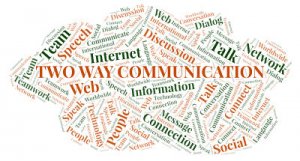Content Marketing – a two-way connection
July 17, 2019
 When you hear the phrase content marketing what does it mean to you? If you’re like most B2B marketers, you may be associating that term with a combination of email campaigns and educational content. Most brands use gated (you have to trade your email address to access the content) content to build their email list and then deploy an email drip campaign to stay connected with the prospect until they are ready to buy.
When you hear the phrase content marketing what does it mean to you? If you’re like most B2B marketers, you may be associating that term with a combination of email campaigns and educational content. Most brands use gated (you have to trade your email address to access the content) content to build their email list and then deploy an email drip campaign to stay connected with the prospect until they are ready to buy.
Or the flip of that, they may offer educational content to their email list that they don’t make available to anyone not in their inner circle. These tactics are highly successful for many companies. But, there’s more to consider.
If you remember, we’ve been talking about three key takeaways from the content marketing trends report from Content Marketing Institute (CMI) and today we will unpack the third takeaway:
- Well-researched personas can help teams create successful content; however, too few content marketers (42%) are actually talking with customers to understand their needs.
- Nearly all of the successful B2B content marketers (90%) prioritize the audience’s informational needs over their sales/promotional message, compared with the 56% of the least successful.
- B2B content marketers primarily use email (87%) and educational content (77%) to nurture their audience and may be missing other opportunities (e.g., only 23% are using community building/audience participation to bring new voices to the table.)
One of the biggest challenges with content marketing is that all too often, we treat it like traditional marketing. We think of it as a monologue. We send out broadcast emails. We produce a blog and turn off the comments. We create an ebook. All effective but not for encouraging conversation. We have an opportunity to actually use our marketing to connect with a prospect or customer who is willing to actually engage with us.
This doesn’t require us to abandon our current monologue efforts. We just have to adapt them.
This blog is a perfect example. Some of the most popular posts are in response to emails I get from readers who ask a question that I can answer in an upcoming post. But I haven’t been consistent in reminding you that you’re welcome to reach out and pose a question or suggest a topic. That’s true for most marketing tactics that appear to be a one-way conversation. They’re capable of being more but we don’t always take advantage of the opportunity.
Audience participation content is the simplest way to have that two-way connection. Building a community is another model but it’s going to take more time, effort and, in many cases, money. The effort yields you huge credibility and currency by positioning you as the brand that is a connector. If your clients are wrestling with some of the same challenges, why not create a place for them to come together to share hacks, best practices, and have the opportunity to learn from each other?
You could create an online forum for a niche audience or put on a conference. On a smaller scale, you could create a Facebook group or plan a quarterly meet up. What’s great about these tactics is that you don’t have to produce all of the content. The audience and their connections and conversations are the content.
A community can also be built around a shared cause or concern. I’m not talking about putting your logo on the back of a t-shirt here but really having a robust program that not only changes the world but changes your relationship with your customer.
We’ll dig into this idea of how to build a community next time because I believe it’s worthy of more attention and consideration.
More








